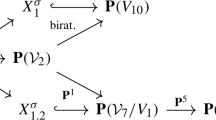Abstract
The aim is to describe two homogeneous affine open sets in some projective spaces. The sets are well known, their groups of automorphisms contain simple exceptional groups of types \(E_6\) or \(E_7\), although the total groups of automorphisms are infinite-dimensional and both the sets are flexible. We prove existence of automorphisms not belonging to the connected components of unity, construct extended Weyl groups including these non-tame automorphisms. Our methods are based on classical combinatorics associated with 27 lines on non-singular cubic surfaces and with 56 exceptional curves on Del Pezzo surfaces of degree 2. Some traditional applications of Jordan algebras are used.


Similar content being viewed by others
References
Arzhantsev, I., Flenner, H., Kaliman, S., Kutzschebauch, F., Zaidenberg, M.: Flexible varieties and automorphism groups. Duke Math. J. 162(4), 767–823 (2013)
Baker, H.F.: Abel’s Theorem and the Allied Theory. Cambridge University Press, Cambridge (1897)
Brown, R.B.: Groups of type \(E_7\). J. Reine Angew. Math. 236, 79–102 (1969)
Cooperstein, B.N.: The fifty-six-dimensional module for \(E_7\): I. A four form for \(E_7\). J. Algebra 173(2), 361–389 (1995)
Dickson, L.E.: The configurations of the 27 lines on a cubic surface and the 28 bitangents to a quartic curve. Bull. Amer. Math. Soc. 8(2), 63–70 (1901)
Freudenthal, H.: Oktaven. Ausnahmegruppen und Oktavengeometrie. Mathematisch Instituut der Rijksuniversiteit te Utrecht, Utrecht (1951)
Freudenthal, H.: Oktaven, Ausnahmegruppen und Oktavengeometrie. In: Springer, T.A., van Dalen, D. (eds.) Hans Freudenthal Selecta, pp. 214–269. European Mathematical Society (EMS), Zürich (2009)
Freudenthal, H.: Oktaven, Ausnahmegruppen und Oktavengeometrie (an extended Russian translation by B.A. Rosenfeld). Matematika 1(1), 117–153 (1957)
Freudenthal, H.: Zur ebenen Oktavengeometrie. Nederl. Akad. Wetensch. Proc. Ser. A 56, 195–200 (1953)
Freudenthal, H.: Zur ebenen Oktavengeometrie. In: Springer, T.A., van Dalen, D. (eds.) Hans Freudenthal Selecta, pp. 288–293. European Mathematical Society (EMS), Zürich (2009)
Henderson, A.: The Twenty-Seven Lines Upon the Cubic Surface. Ph.D. Thesis, University of Chicago (1915)
Jacobson, N.: Structure and Representations of Jordan Algebras. American Mathematical Society Colloquium Publications, vol. 39. American Mathematical Society, Providence (1968)
Jordan, C.: Traité des Substitutions Algébriques. Gauthier-Villars, Paris (1870)
Manin, Yu.I.: Cubic Forms. Nauka, Moscow (1972); English translation by M. Hazewinlel, North-Holland Mathematical Library, vol. 4. North-Holland, Amsterdam (1986)
Miller, G.A., Blichfeldt, H.F., Dickson, L.E.: Theory and Applications of Finite Groups. Wiley, New York (1916)
McCrimmon, K.: A Taste of Jordan Algebras. Universitext. Springer, New York (2004)
Salmon, G.: A Treatise on the Higher Plane Curves, 3rd edn. Hodges, Foster, Dublin (1879)
Salmon, G.: Analytische Geometrie der Höheren ebenen Curven (German translation by W. Fiedler). Teubner, Leipzig (1873)
Shafarevich, I.R.: On some infinite-dimensional groups. II. Math. USSR-Izv. 18(1), 185–194 (1982)
Springer, T.A., Veldkamp, F.D.: Octonions, Jordan Algebras and Exceptional Groups. Springer Monographs in Mathematics. Springer, Berlin (2000)
Acknowledgements
First of all the author would like to express his gratitude to Ernest Vinberg, who attracted the attention of listeners to the subject during his lectures at the Moscow conference “Lie algebras, Algebraic Groups and Theory of Invariants” (January 30–February 4, 2017). His lecture from February, 4 was devoted to exceptional groups and the cubic form \(F_3\). The author also wishes to thank Ivan Cheltsov who encouraged to contribute to the collection dedicated to William Edge. The author is truly grateful to an anonymous referee for his/her efforts, remarks and comments.
Author information
Authors and Affiliations
Corresponding author
Additional information
In memory of William Edge
Appendix: Matrix \({\mathbb {M}}(F_3)\)
Appendix: Matrix \({\mathbb {M}}(F_3)\)

Rights and permissions
About this article
Cite this article
Gizatullin, M. Two examples of affine homogeneous varieties. European Journal of Mathematics 4, 1035–1064 (2018). https://doi.org/10.1007/s40879-018-0228-y
Received:
Revised:
Accepted:
Published:
Issue Date:
DOI: https://doi.org/10.1007/s40879-018-0228-y



